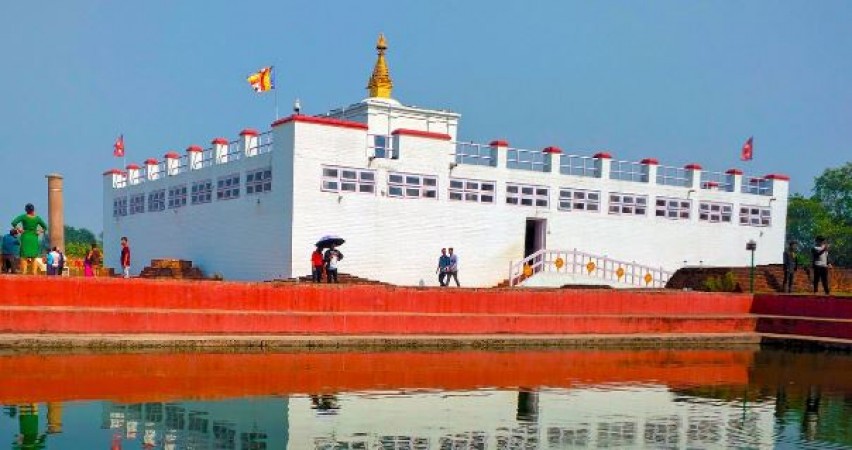
Maya Devi Temple is the ancient Buddhist temple nestled in the picturesque plains of southern Nepal, Lumbini is a place of immense religious significance for millions of Buddhists worldwide. It is revered as the birthplace of Siddhartha Gautama, who would later become known as Lord Buddha—the enlightened one. The Maya Devi Temple stands at the heart of this holy site, marking the exact spot where Queen Maya Devi gave birth to Prince Siddhartha. With its rich history, spiritual aura, and architectural splendor, the temple serves as a potent symbol of peace and enlightenment.
Lumbini's significance as a sacred site can be traced back to the 6th century BCE when it was part of the ancient kingdom of Kapilavastu. Queen Maya Devi, the wife of King Suddhodana and mother of Siddhartha Gautama, was traveling to her parental home in Devadaha when she gave birth to the future Buddha. The birth is said to have occurred in the Lumbini Garden, under a sal tree.
Also Read: Kakanmath Temple:Ghosts Built Shiva temple
Over the centuries, the location was forgotten and lost, until the late 19th century when the rediscovery of Lumbini became a matter of great archaeological interest. In 1896, archaeologist General Khadga Shumsher Rana unearthed the Ashokan Pillar, which contained inscriptions validating Lumbini's historical significance. Since then, a series of excavations has revealed the foundations of ancient monastic buildings, confirming the area's connection to Buddhism.
For Buddhists, Lumbini is one of the four holiest places on Earth, known as the Four Sacred Sites of Buddhism, the others being Bodh Gaya (where Buddha attained enlightenment), Sarnath (where he gave his first sermon), and Kushinagar (where he achieved Parinirvana or final nirvana). Lumbini's sanctity lies in being the birthplace of the Buddha, the spiritual teacher whose teachings form the foundation of Buddhism.
Devotees from all corners of the world visit the Maya Devi Temple to pay their respects and seek blessings. Pilgrimage to Lumbini is considered an act of merit and devotion, believed to bring spiritual awakening and purification of one's karma. The temple complex has become a significant site for meditation, reflection, and study of Buddhist philosophy.
Also Read: Ayodhya Ram Temple Bhumi Pujan: An Occasion Signifying Unity, Faith
The Maya Devi Temple stands as the central monument in Lumbini, with a design that harmonizes Buddhist and Mauryan architecture. The current temple is believed to have been constructed in the 3rd century BCE, replacing earlier structures built by Emperor Ashoka and other rulers.
The temple is built on a foundation that protects the archaeological remains of ancient structures, and its entrance faces the east, as per traditional Hindu and Buddhist architectural practices. The main sanctum enshrines a stone representation of the nativity scene, depicting Queen Maya Devi giving birth to Siddhartha Gautama. The exact spot of the birth is marked with a marker stone.
Surrounding the temple is a courtyard with a sacred pond called "Puskarni" or the "Holy Pond." According to legend, Queen Maya Devi took a ritual bath in this pond before giving birth. Devotees often take water from this pond, considering it to possess healing properties.
Also Read: Kom Ombo Temple: A Fascinating Ancient Marvel in Egypt
The Maya Devi Temple, with its historical and spiritual significance, plays a crucial role in propagating Buddhism around the world. It attracts scholars, pilgrims, and tourists alike, fostering an understanding of Buddhist teachings and its impact on various cultures and societies. Lumbini has been inscribed as a UNESCO World Heritage Site since 1997, further enhancing its global recognition and preservation.
The temple's existence and the broader Lumbini site have facilitated interfaith dialogues and exchanges, promoting religious tolerance and understanding. It serves as a symbol of peace, encouraging people to embrace non-violence and compassion, as espoused by Lord Buddha.
Additionally, the Maya Devi Temple contributes significantly to Nepal's tourism industry, attracting visitors from diverse backgrounds, who come seeking a glimpse of history, spirituality, and cultural heritage. This influx of tourists helps in local economic development and fosters cultural exchange.
Also Read: India's Top Nine Locations for Culture Lovers
the Maya Devi Temple in Lumbini stands as a testament to the historical and spiritual legacy of Buddhism. It is a sacred place of birth, enlightenment, and inspiration, drawing millions of devotees, scholars, and travelers from across the globe. With its profound impact on Buddhism and its contributions to promoting peace and understanding, the temple continues to be a beacon of hope, compassion, and enlightenment for all. The legacy of Lumbini, as the birthplace of Lord Buddha, remains etched in the hearts of millions, and the Maya Devi Temple stands as an enduring symbol of this timeless heritage.
Also Read: Hollywood Sikh Temple: Promoting Interfaith Dialogue and Understanding
Malta: A Mediterranean Gem with a Rich Tapestry of History and Beauty
Archaeologists Unearth New Discoveries at the Ancient Temple of Bel in Dura-Europos